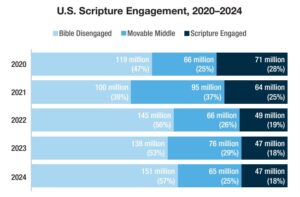
Editor’s note: Read previous columns about the “Jesus’ wife fragment” here and here
NEW ORLEANS (BP) — Various news outlets, perhaps jumping to cast doubt on the Bible, caused a stir over the announcement of a small, newly translated Coptic manuscript fragment indicating that Jesus may have had a wife.
But what should Christians make of the new claim?
Not much, according to scholars at New Orleans Baptist Theological Seminary. In fact, the scholar who presented the discovery Sept. 18 at the International Association of Coptic Studies in Rome downplayed any possible link between the Coptic fragment and the Jesus of the New Testament Gospels.
James Leonard, assistant registrar at New Orleans Seminary’s Leavell College, studied Coptic texts intensively during his doctor of philosophy studies at Cambridge University, ultimately writing his dissertation on a Coptic manuscript of Matthew. And while he has only seen photographs of the recent discovery, he is skeptical about the authenticity of the document. Even if the document were proven to be authentic, Leonard said it does not have historical value in understanding Jesus.
“We have to start out by deciding whether the fragment is ancient or if it is a modern forgery. If it’s a forgery, what do you do, you just throw it out,” Leonard said. “If it is indeed ancient — going back to the fourth century or even to the second century — it still would have no historical value pertinent to Jesus’ life, given that its witness is so late.
“To say it’s ancient does not mean it has any relevance to help us understand Jesus’ life and ministry on earth,” Leonard said.
The papyrus fragment, smaller than a business card, includes eight lines of handwritten text in the Coptic language. Derived from the Greek alphabet, Coptic is essentially the Egyptian language represented with an alphabet rather than hieroglyphics. Some who have commented about the fragment note a strong resemblance to the non-canonical Gnostic manuscript known as the Gospel of Thomas.
Karen L. King, the Harvard University scholar who has been studying the manuscript, believes it is a genuine fourth-century copy of a second-century text. However, the owner of the fragment has not been identified and little is known about the document’s origins. King has repeatedly issued cautions to the media. The text, she said, does not provide historically reliable data regarding Jesus’ marital status.
Key figures in the textual studies discipline are split on whether the document is authentic, that is, whether the document was written in the fourth century. Some scholars, including Roger Bagnall of New York University and AnneMarie Luijendijk of Princeton, have joined King in arguing for the document’s authenticity. Other scholars, including professors Leonard worked closely with during his doctoral studies, Francis Watson of Durham University and Simon Gathercole of Cambridge, have pointed out what they believe are tell-tale signs of forgery. Watson, in a paper posted online at www.markgoodacre.org/Watson.pdf, argues that the text appears to be constructed by a modern author rather than an ancient native Coptic speaker.
“Watson shows how the fragment looks as if a forger took snippets of quotations from various Coptic sources — mostly the Gospel of Thomas — and patched them together,” Leonard said. “Indeed, one line of the fragment ‘coincidentally’ ends at the same place where the text is broken off in the corresponding line of the only extant manuscript of the Gospel of Thomas.”
Simon Gathercole at Cambridge sees another reason for concern: the most inflammatory statement in the manuscript is squarely in the center of the fragment. While the shocking statement is in the middle, key explanatory information is missing because of where the document is torn.
Bill Warren, New Testament professor and director of the Haggard Center for New Testament Textual Studies at NOBTS, has been following the discussion about the new discovery. Warren said the “clean cuts” and careful framing of “my wife” without the surrounding words to provide context creates suspicion about the document’s authenticity.
“If we assume that the fragment is authentic, the placement of the main statement being discussed about Jesus saying ‘my wife’ right in the center of the fragment is at best suspicious, and the lack of a fuller context for knowing what exactly was being said lends itself to speculations that may be far off the mark if only a fuller context was known,” Warren said. “For example, was Jesus answering a question about ‘my wife’ and so used the wording from the questioner? We simply don’t know the context.”
Warren also mentioned the detail most news outlets have apparently missed. The scholars who believe the document dates to the fourth century and those who believe it is a modern forgery agree on one thing. The fragment does not offer credible facts about Jesus.
“This fragment even if authentic does not tell us anything about the historical Jesus, even as Karen King herself admits, but some in the press seem to overlook,” Warren said. “Rather it tells us about either a divergent group’s deviant beliefs or someone’s strange imagination-driven ideas about Jesus.”
NOBTS theology and philosophy professor Robert Stewart, who has a background in historical Jesus studies, echoed the questions from Leonard and Warren concerning the authenticity of the document. Discovering whether the fragment is authentic or not will take time and research. The source of reliable information about Jesus’ life and ministry is not in question. According to Stewart, the Bible is the best source for learning about Jesus.
“Despite the fact that the media will certainly trumpet this ‘find,’ the best sources for information about Jesus remain Mark, Matthew, Luke and John,” Stewart said.
“Even if [the fragment] is authentic, all it tells us with some degree of certainty is what someone who could not have lived within the lifetime of the historical Jesus wrote about Jesus,” Stewart said. “This means that it, at best, deserves to be grouped among other late documents that say sensationalistic things about Jesus, like the Gospel of Judas or Peter, which very few historians take seriously as a source about Jesus.”
NOBTS Provost Steve Lemke agreed.
“Even if this scrap of paper proves to be authentic — and there is significant doubt about that — it really doesn’t prove anything about what Jesus did or said,” Lemke said. “There were false claims and heretical teachings in the fourth century, just as there have been throughout time.
“The best sources of information about Jesus are still in the canonical Gospels, because they were inspired by the Holy Spirit and record the eyewitness accounts of the apostles.”
–30–
Gary D. Myers is director of public relations at New Orleans Baptist Theological Seminary. Get Baptist Press headlines and breaking news on Twitter (@BaptistPress), Facebook (Facebook.com/BaptistPress ) and in your email ( baptistpress.com/SubscribeBP.asp).














